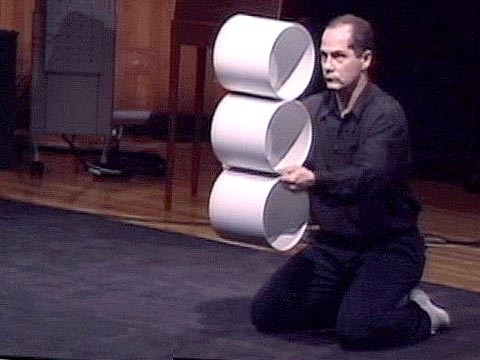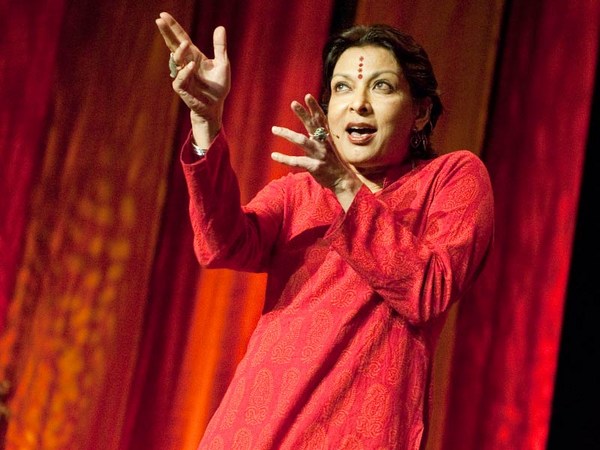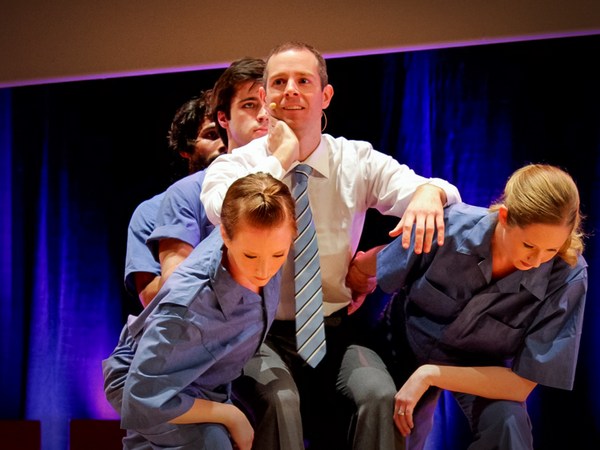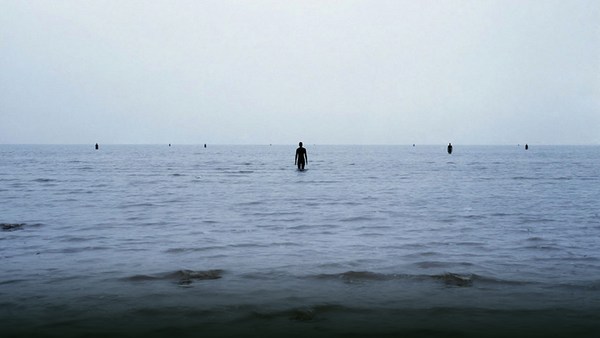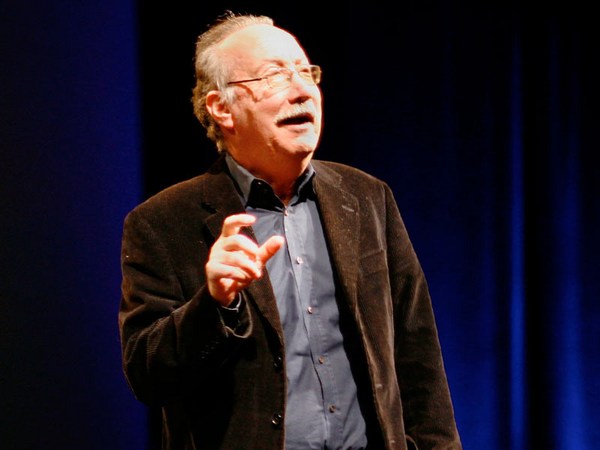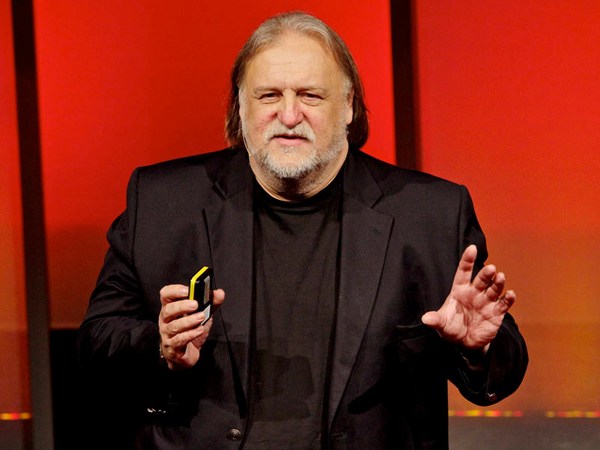As you might imagine, I'm absolutely passionate about dance. I'm passionate about making it, about watching it, about encouraging others to participate in it, and I'm also really passionate about creativity. Creativity for me is something that's absolutely critical, and I think it's something that you can teach. I think the technicities of creativity can be taught and shared, and I think you can find out things about your own personal physical signature, your own cognitive habits, and use that as a point of departure to misbehave beautifully.
I was born in the 1970s, and John Travolta was big in those days: "Grease," "Saturday Night Fever," and he provided a fantastic kind of male role model for me to start dancing. My parents were very up for me going. They absolutely encouraged me to take risks, to go, to try, to try. I had an opportunity, an access to a local dance studio, and I had an enlightened teacher who allowed me to make up my own and invent my own dances, so what she did was let me make up my own ballroom and Latin American dances to teach to my peers. And that was the very first time that I found an opportunity to feel that I was able to express my own voice, and that's what's fueled me, then, to become a choreographer. I feel like I've got something to say and something to share.
And I guess what's interesting is, is that I am now obsessed with the technology of the body. I think it's the most technologically literate thing that we have, and I'm absolutely obsessed with finding a way of communicating ideas through the body to audiences that might move them, touch them, help them think differently about things.
So for me, choreography is very much a process of physical thinking. It's very much in mind, as well as in body, and it's a collaborative process. It's something that I have to do with other people. You know, it's a distributed cognitive process in a way. I work often with designers and visual artists, obviously dancers and other choreographers, but also, more and more, with economists, anthropologists, neuroscientists, cognitive scientists, people really who come from very different domains of expertise, where they bring their intelligence to bear on a different kind of creative process.
What I thought we would do today a little bit is explore this idea of physical thinking, and we're all experts in physical thinking. Yeah, you all have a body, right? And we all know what that body is like in the real world, so one of the aspects of physical thinking that we think about a lot is this notion of proprioception, the sense of my own body in the space in the real world. So, we all understand what it feels like to know where the ends of your fingers are when you hold out your arms, yeah? You absolutely know that when you're going to grab a cup, or that cup moves and you have to renavigate it. So we're experts in physical thinking already. We just don't think about our bodies very much. We only think about them when they go wrong, so, when there's a broken arm, or when you have a heart attack, then you become really very aware of your bodies. But how is it that we can start to think about using choreographic thinking, kinesthetic intelligence, to arm the ways in which we think about things more generally?
What I thought I'd do is, I'd make a TED premiere. I'm not sure if this is going to be good or not. I'll just be doing it. I thought what I'd do is, I'd use three versions of physical thinking to make something.
I want to introduce you. This is Paolo. This is Catarina.
(Applause)
They have no idea what we're going to do. So this is not the type of choreography where I already have in mind what I'm going to make, where I've fixed the routine in my head and I'm just going to teach it to them, and these so-called empty vessels are just going to learn it. That's not the methodology at all that we work with. But what's important about it is how it is that they're grasping information, how they're taking information, how they're using it, and how they're thinking with it.
I'm going to start really, really simply. Usually, dance has a stimulus or stimuli, and I thought I'd take something simple, TED logo, we can all see it, it's quite easy to work with, and I'm going to do something very simply, where you take one idea from a body, and it happens to be my body, and translate that into somebody else's body, so it's a direct transfer, transformation of energy.
And I'm going to imagine this, you can do this too if you like, that I'm going to just take the letter "T" and I'm going to imagine it in mind, and I'm going to place that outside in the real world. So I absolutely see a letter "T" in front of me. Yeah? It's absolutely there. I can absolutely walk around it when I see it, yeah? It has a kind of a grammar. I know what I'm going to do with it, and I can start to describe it, so I can describe it very simply. I can describe it in my arms, right? So all I did was take my hand and then I move my hand. I can describe it, whoa, in my head, you know? Whoa. Okay. I can do also my shoulder. Yeah? It gives me something to do, something to work towards. If I were to take that letter "T" and flatten it down on the floor, here, maybe just off the floor, all of a sudden I could do maybe something with my knee, yeah? Whoa. So If I put the knee and the arms together, I've got something physical, yeah? And I can start to build something. So what I'm going to do just for one and a half minutes or so is I'm going to take that concept, I'm going to make something, and the dancers behind me are going to interpret it, they're going to snapshot it, they're going to take aspects of it, and it's almost like I'm offloading memory and they're holding onto memory? Yeah? And we'll see what we come up with. So just have a little watch about how they're, how they're accessing this and what they're doing, and I'm just going to take this letter "T," the letter "E," and the letter "D," to make something. Okay. Here goes.
So I have to get myself in the zone. Right.
It's a bit of a cross of my arm.
So all I'm doing is exploring this space of "T" and flashing through it with some action. I'm not remembering what I'm doing. I'm just working on my task. My task is this "T." Going to watch it from the side, whoa. Strike moment. That's it.
So we're starting to build a phrase.
So what they're doing, let's see, something like that, so what they're doing is grasping aspects of that movement and they're generating it into a phrase. You can see the speed is extremely quick, yeah? I'm not asking them to copy exactly. They're using the information that they receive to generate the beginnings of a phrase. I can watch that and that can tell me something about how it is that they're moving. Yeah, they're super quick, right?
So I've taken this aspect of TED and translated it into something that's physical. Some dancers, when they're watching action, take the overall shape, the arc of the movement, the kinetic sense of the movement, and use that for memory. Some work very much in specific detail. They start with small little units and build it up. Okay, you've got something? One more thing.
So they're solving this problem for me, having a little -- They're constructing that phrase. They have something and they're going to hold on to it, yeah? One way of making. That's going to be my beginning in this world premiere.
Okay. From there I'm going to do a very different thing. So basically I'm going to make a duet. I want you to think about them as architectural objects, so what they are, are just pure lines. They're no longer people, just pure lines, and I'm going to work with them almost as objects to think with, yeah? So what I'm thinking about is taking a few physical extensions from the body as I move, and I move them, and I do that by suggesting things to them: If, then; if, then. Okay, so here we go.
Just grab this arm. Can you place that down into the floor? Yeah, down to the floor. Can you go underneath? Yeah. Cat, can you put leg over that side? Yeah. Can you rotate? Whoom, just go back to the beginning. Here we go, ready? And ... bam, bake ... (clicks metronome) Great. Okay, from there, you're both getting up. You're both getting up. Here we go. Good, now? Them.
(Applause)
So from there, from there, we're both getting up, we're both getting up, going in this direction, going underneath. Whoa, whoa, underneath. Whoa, underneath, whoo-um. Yeah? Underneath. Jump. Underneath. Jump. Paolo, kick. Don't care where. Kick. Kick, replace, change a leg. Kick, replace, change the leg. Yeah? Okay? Cat, almost get his head. Almost get his head. Whoaa. Just after it, maybe. Whoaa, whaaay, ooh. Grab her waist, come up back into her first, whoom, spin, turn her, whoo-aa. (Snaps) Great. Okay, let's have a little go from the beginning of that. Just, let me slow down here. Fancy having eight -- (Laughter)
Fancy having eight hours with me in a day. So, maybe too much. So, here we go, ready, and -- (Clicks metronome)
(Clicks metronome)
Nice, good job. Yeah? Okay. (Applause) Okay, not bad. (Applause) A little bit more? Yeah. Just a little bit more, here we go, from that place. Separate. Face the front. Separate. Face the front. Imagine that there's a circle in front of you, yeah? Avoid it. Avoid it. Whoom. Kick it out of the way. Kick it out of the way. Throw it into the audience. Whoom. Throw it into the audience again. We've got mental architecture, we're sharing it, therefore solving a problem. They're enacting it. Let me just see that a little bit. Ready, and go.
(Clicks metronome)
Okay, brilliant. Okay, here we go. From the beginning, can we do our phrases first? And then that. And we're going to build something now, organize it, the phrases. Here we go. Nice and slow? Ready and go ... um. (Clicks metronome)
(Clicks metronome) The duet starts. (Clicks metronome) (Clicks metronome) So yeah, okay, good. Okay, nice, very nice. (Applause)
So good. So -- (Applause) Okay. So that was -- (Applause) Well done. (Applause)
That was the second way of working. The first one, body-to-body transfer, yeah, with an outside mental architecture that I work with that they hold memory with for me. The second one, which is using them as objects to think with their architectural objects, I do a series of provocations, I say, "If this happens, then that. If this, if that happens -- " I've got lots of methods like that, but it's very, very quick, and this is a third method. They're starting it already, and this is a task-based method, where they have the autonomy to make all of the decisions for themselves.
So I'd like us just to do, we're going to do a little mental dance, a little, in this little one minute, so what I'd love you to do is imagine, you can do this with your eyes closed, or open, and if you don't want to do it you can watch them, it's up to you. Just for a second, think about that word "TED" in front of you, so it's in mind, and it's there right in front of your mind. What I'd like you to do is transplant that outside into the real world, so just imagine that word "TED" in the real world. What I'd like you to do what that is take an aspect of it. I'm going to zone in on the "E," and I'm going to scale that "E" so it's absolutely massive, so I'm scaling that "E" so it's absolutely massive, and then I'm going to give it dimensionality. I'm going to think about it in 3D space. So now, instead of it just being a letter that's in front of me, it's a space that my body can go inside of. I now decide where I'm going to be in that space, so I'm down on this small part of the bottom rib of the letter "E," and I'm thinking about it, and I'm imagining this space that's really high and above. If I asked you to reach out — you don't have to literally do it, but in mind — reach out to the top of the "E," where would you reach? If you reach with your finger, where would it be? If you reach with your elbow, where would it be? If I already then said about that space that you're in, let's infuse it with the color red, what does that do to the body? If I then said to you, what happens if that whole wall on the side of "E" collapses and you have to use your weight to put it back up, what would you be able to do with it?
So this is a mental picture, I'm describing a mental, vivid picture that enables dancers to make choices for themselves about what to make.
Okay, you can open your eyes if you had them closed.
So the dancers have been working on them. So just keep working on them for a little second. So they've been working on those mental architectures in the here. I know, I think we should keep them as a surprise.
So here goes, world premiere dance. Yeah? Here we go. TED dance. Okay. Here it comes. I'm going to organize it quickly. So, you're going to do the first solo that we made, yeah blah blah blah blah, we go into the duet, yeah, blah blah blah blah. The next solo, blah blah blah blah, yeah, and both at the same time, you do the last solutions.
Okay? Okay. Ladies and gentlemen, world premiere, TED dance, three versions of physical thinking. (Applause) Well, clap afterwards, let's see if it's any good, yeah? (Laughter) So yeah, let's clap -- yeah, let's clap afterwards. Here we go. Catarina, big moment, here we go, one.
(Clicks metronome) Here it comes, Cat. (Clicks metronome) Paolo, go. (Clicks metronome) Last you solo. The one you made. (Clicks metronome) (Clicks metronome) Well done. Okay, good. Super. So --
(Applause) So -- (Applause) Thank you. (Applause) So -- three versions. (Applause) Oh. (Laughs) (Applause) Three versions of physical thinking, yeah? Three versions of physical thinking. I'm hoping that today, what you're going to do is go away and make a dance for yourself, and if not that, at least misbehave more beautifully, more often.
Thank you very much. (Applause) Thank you. Thank you. (Applause) Here we go. (Applause) (Applause)
